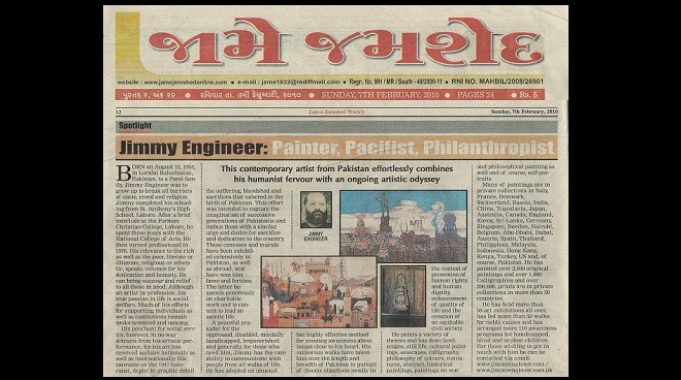India’s second oldest newspaper
Living Legends - II
Jam-e-Jamshed: Asia’s second oldest newspaper
Jam-e-Jamshed is Asia’s second oldest newspaper. Ten years after the first newspaper in Asia, Bombay Samachar, was launched in Mumbai (which interestingly still comes out from the same place where it was started), an influential Parsi family, the Marzbans, started a Gujarati newspaper titled Jam-e-Jamshed mainly for the Parsi community. It was first published as a weekly on 12th March 1832 from its own distinctive red brick building at Ballard Pier near the Mumbai Docks. In 1853, it was converted into a daily.
In Persian, Jam-e-Jamshed means the jam-goblet of Shah Jamshid. This has two implications. One is the jam of spiritual intoxication - Ishq-e-Hakiki - the love for the Divine and the other is the jam of the World-Time, in which all the past, present and future can be seen.
The early 19th century was an interesting time for people living in Bombay trying to do business. This was the time when Gujaratis, Parsis and Bohras, the three key trading communities, were slowly establishing themselves in and around Mumbai Port. And with the trade bourse coming up, the emergence of a newspaper was inevitable. The first newspapers coming out from Bombay carried reports primarily revolving around businesses in Europe as well as events that affected the Indian sub-continent.
Jam-e-Jamshed’s primary focus was the Parsi community. K.N. Dastoor writes: “In those days, Parsi life was entirely unique. They were in Hindustan for more than a thousand years. They were intensely conscious that they were on this holy land of rishis and saints to preserve and protect their religious institutions viz. (1) Sudreh Kushti, (2) Manthra Prayers, (3) Yasna (Kriyakaam), (4) Temples of the Holy Fire, (5) Dokhma, (6) a stringent moral code of truth, charity and repentance (Meher-Patet) loosely called 'good' thoughts, words and deeds, and (7) above all Boonak-Paasbaani, the protection of the racial gene.
Jam-e-Jamshed was all for these institutions, actively helping the Parsis to make them an integral part of their day-to-day life. Being a daily, it also functioned like a national newspaper, with all the current news and views on politics and social life but its main function was to remind Parsis constantly about their religious heritage and culture and keep them alive and thundering in the midst of whatever political turmoil happened to be around.
Dastoor argues that Jam-e-Jamshed was mainly responsible for keeping Parsi public opinion on the track of orthodoxy. It fought against the reformist wave which was in vogue during the late 19th and early 20th century and stood against conversion, mixed marriages, and mixed Navjote.
There was opposition from within the community against the orthodox editorial policy of Jam-e-Jamshed and attempts were made to usher in reforms. From the 1940s till about the 1960s, the paper tried to promote reformist ideas, especially with Fram Bulsara as joint editor but this effort provoked stiff opposition from the orthodox.
During the early 20th century, the newspaper reported on the freedom struggle. If Parsis were the first to embrace several aspects of a western lifestyle, they were also among the first and most intensely involved in the freedom struggle. The paper chronicled the struggle for freedom.
By the 1960s, Jam-e-Jamshed’s financial crisis was deepening. Nanabhai Beheramji tried to rescue the situation with a virtual takeover and by gradually tilting back to the orthodox line. Keki Katki, a reputed journalist, worked for Jam-e-Jamshed and wrote extensively on religious matters but the paper continued to lose steam. The daily Jam-e Jamshed closed down but it continued as a weekly.
Although the paper was (and is) primarily for the Parsi community, it was not limited to the community. In fact, as the present editor Shernaaz Engineer, a former journalist with the Afternoon Despatch & Courier, said in an interview[1]with Prabhat Sharan of the Deccan Herald about its readership: "The newspaper primarily had a readership from the trading communities. And Parsis, of course, comprised a major chunk. But then another huge chunk of readership came from the Bohra community. Both are business communities. And since Parsis are the original “argumentative Indians” the newspaper also had moorings in carrying extreme views and debates on every topic on the earth. Therefore it had a spectrum of diverse readership from other communities.”
However, Jam-e-Jamshed has moved with the times, literally and symbolically. It has moved out of its red brick building near the Mumbai docks, a move that symbolizes the fact that it has now become a global Parsi community newspaper and, as such, the voice of Parsis worldwide. But even though more and more Parsis are settling abroad, they want to remain connected with the homeland and a publication like Jam-e-Jamshed meets this need.
It is now published as a weekly in Gujarati and English, in fact, more English than Gujarati - earlier it was 12 pages in Gujarati and four pages in English (the present editor, Shernaaz Engineer, reversed this) and has an online and social media presence.
[1]http://parsikhabar.net/individuals/shernaaz-engineer-editor-of-jame-jamshed-in-conversation/4349/#.VzH5fS-KTIU
Dr Mrinal Chatterjee is professor and head of the Indian Institute of Mass Communications, Dhenkenal, Odisha mrinalchatterjeeiimc@gmail.com







